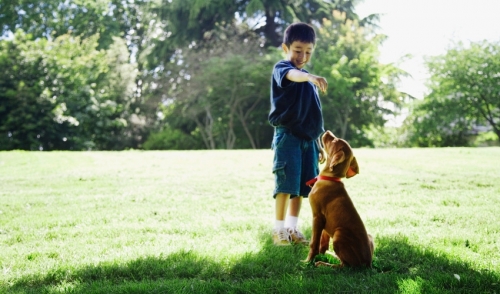{article.name}
Using Gestures for Dog Training

- Share this:
- Share on Facebook
- Pin on Pinterest
- Tweet on Twitter
Training is an essential part of being a responsible dog owner, whether you want your canine companion to learn basic manners, show off with tricks, take top place in shows, or perform useful functions. Gestures can be a great way to issue commands, and it is easier than many dog lovers realize to use gestures for dog training with fantastic results.
Why Use Gestures?
While voice commands are the most common way many dog owners interact with their pets, gestures can be even more practical for dog training. Gestures are ideal when…
- The situation is noisy and your dog can easily see you, but may not hear a verbal command.
- Your dog is far away but can still see large gestures from a distance.
- You may not be able to speak to your dog, such as when you are on the phone.
- The dog is being trained for sensitive work, such as police commands, that may require silence.
- Your dog may lose its hearing as it ages, but can still see gestures well.
- When different people may have different tones of voice, but still want to issue commands.
Because dogs are attuned to body language, using gestures for training is also more intuitive for the animal to understand, and gestures offer another means of effective communication between you and your pet. By taking advantage of that communication, you can strengthen your bond and work even better together.
Choosing Gestures for Your Dog
It is easy to choose which gestures are best for which commands you want your dog to learn. Opt for simple motions that are easy to understand, and the best gestures will mimic the action you want your dog to perform. Popular choices include…
- Holding your hand above your dog’s nose for “Sit” – as if you were holding a treat for the dog to earn, which is a popular way of training this basic command.
- Holding your palm firmly up and facing out for “Stop” or “Stay” – providing that visual barrier or blockade for any advancing motion.
- Pointing your finger to the ground for a “Down” or “Lay Down” command – giving the dog the indication that you want him to drop to the ground.
- Crossing your arm diagonally across your chest for “Come” or “To Me” – this is a large, bring-in gesture easy to see from a distance.
- Tapping the floor in front of your dog with your foot for finger for “Drop It” – indicating where you want the dog to place the object it’s holding.
While these are some basic gestures that many dog owners use, you can choose your own body language to communicate with your dog. The key is to use big, broad gestures that can be seen from distances or will be noticeable if your dog might be otherwise distracted. This will allow you to communicate from afar, and more obvious gestures will also be helpful for others to learn as well as more visible if your dog’s eyesight fades in its senior years.
How to Use Gestures to Train Your Dog
It is no more difficult to use gestures for dog training than it is to get your dog to respond to verbal commands; in fact, using gestures can be easier since they will be more intuitive for your dog’s sense of body language. Starting early with training can help your dog learn the signals and gestures more quickly, but it’s never too late to add visual clues to your dog’s training regimen.
- Be firm but kind with commands. If your dog doesn’t get the new command right away, do not punish the mistakes but simply withhold the reward.
- Use both verbal and gestured commands at first to give your dog more clues about the proper behavior, especially if they have already learned some verbal commands.
- Stay consistent in how gestures are used and what response you expect. This includes teaching others the proper gestures so everyone commanding the dog does so the same way.
- Reinforce your dog’s correct responses with treats and praise to reward positive progress and encourage repeating the behavior.
- Keep training sessions short so the dog does not get bored or confused with too much repetition. A fun session will always be more productive and meaningful.
- Practice commands regularly even after your dog has learned to respond to gestures, just to remind them of the proper behavior and keep their memory fresh.
Above all, always be patient with your dog. It may take several training sessions for your pet to catch on to gestured commands, but eventually you will have a stronger bond and smarter communication between you with every command you give.
Special Offers
We are constantly adding new specials to our site. Be sure to check back often!



Comments